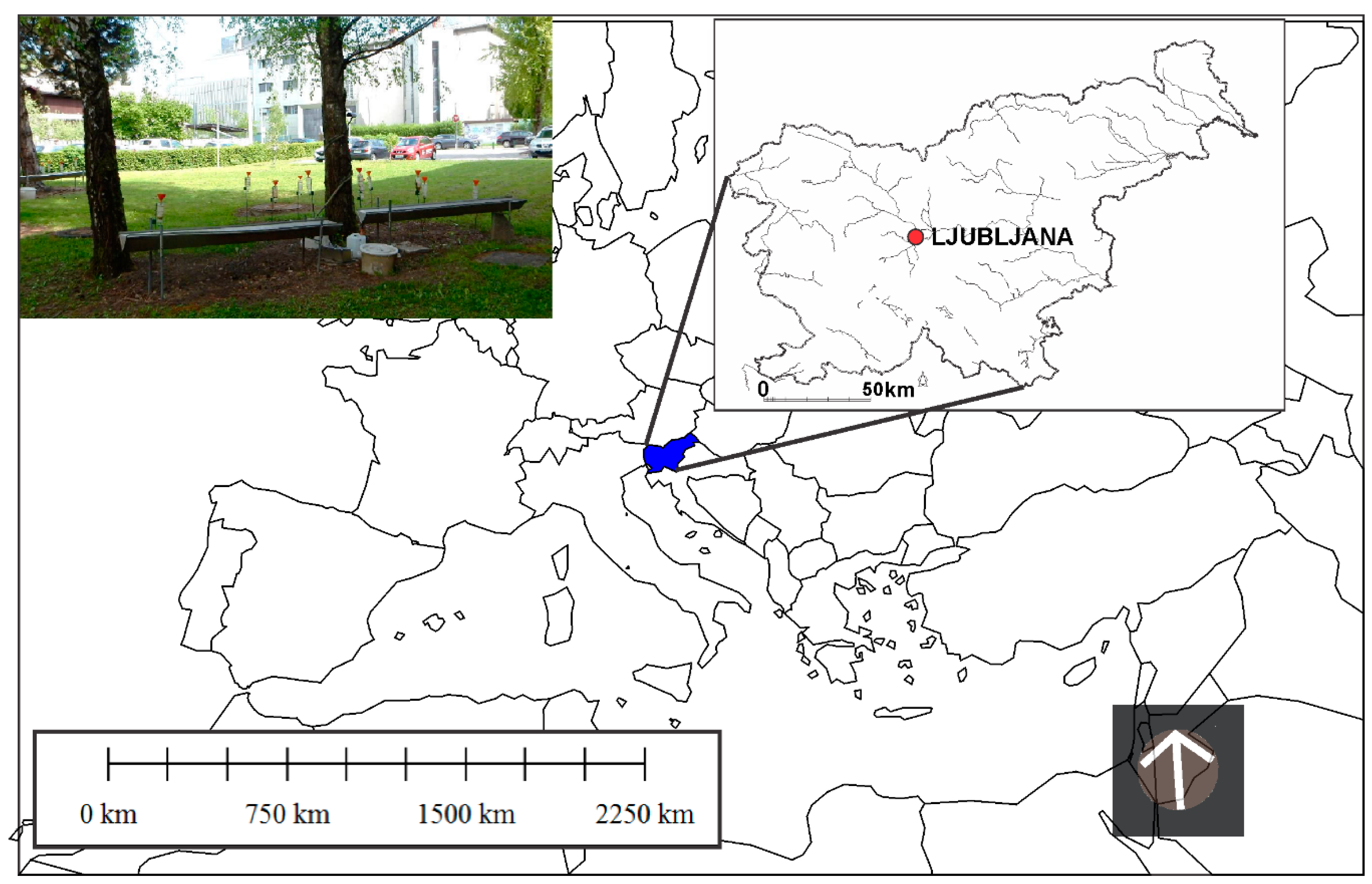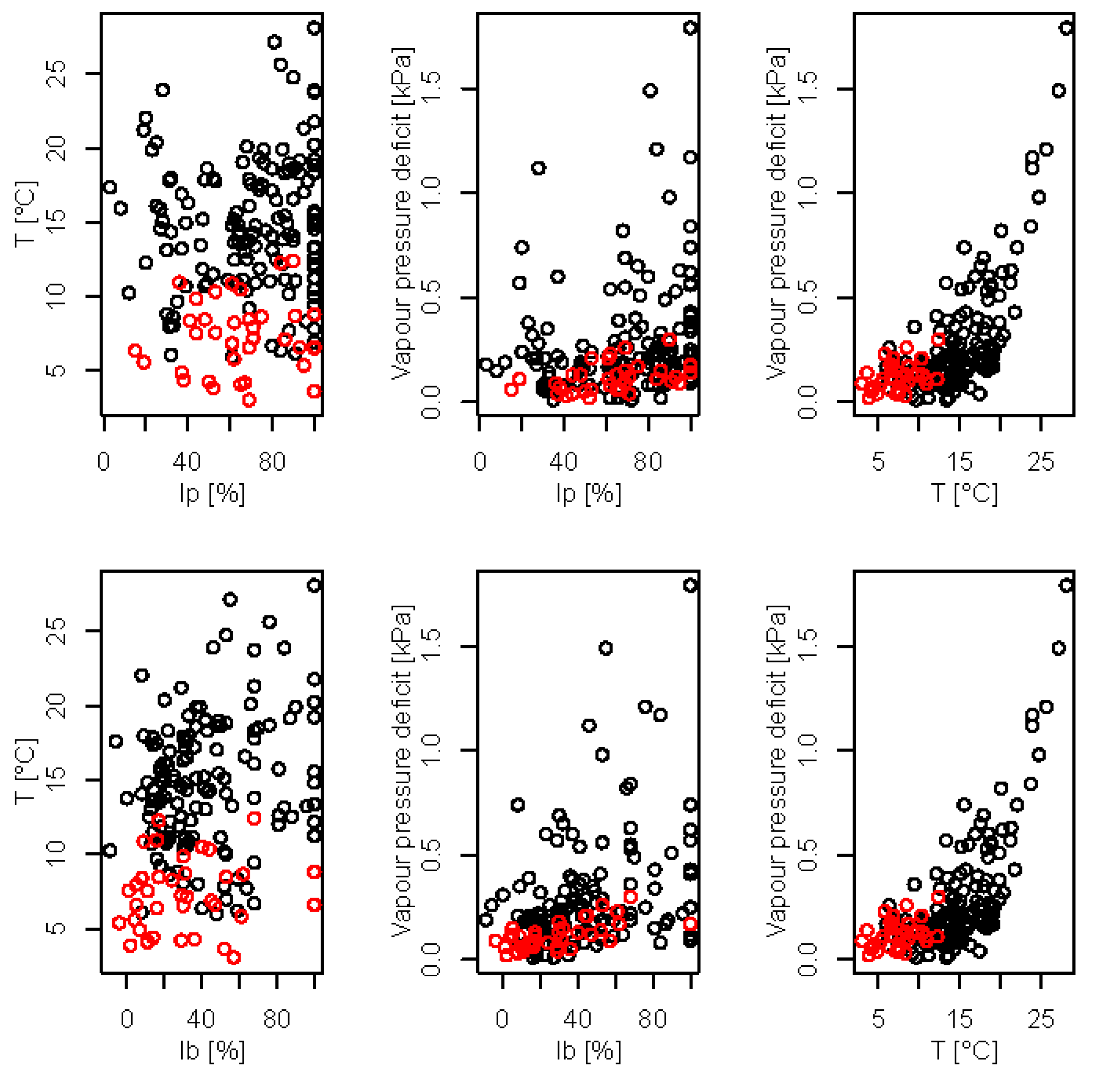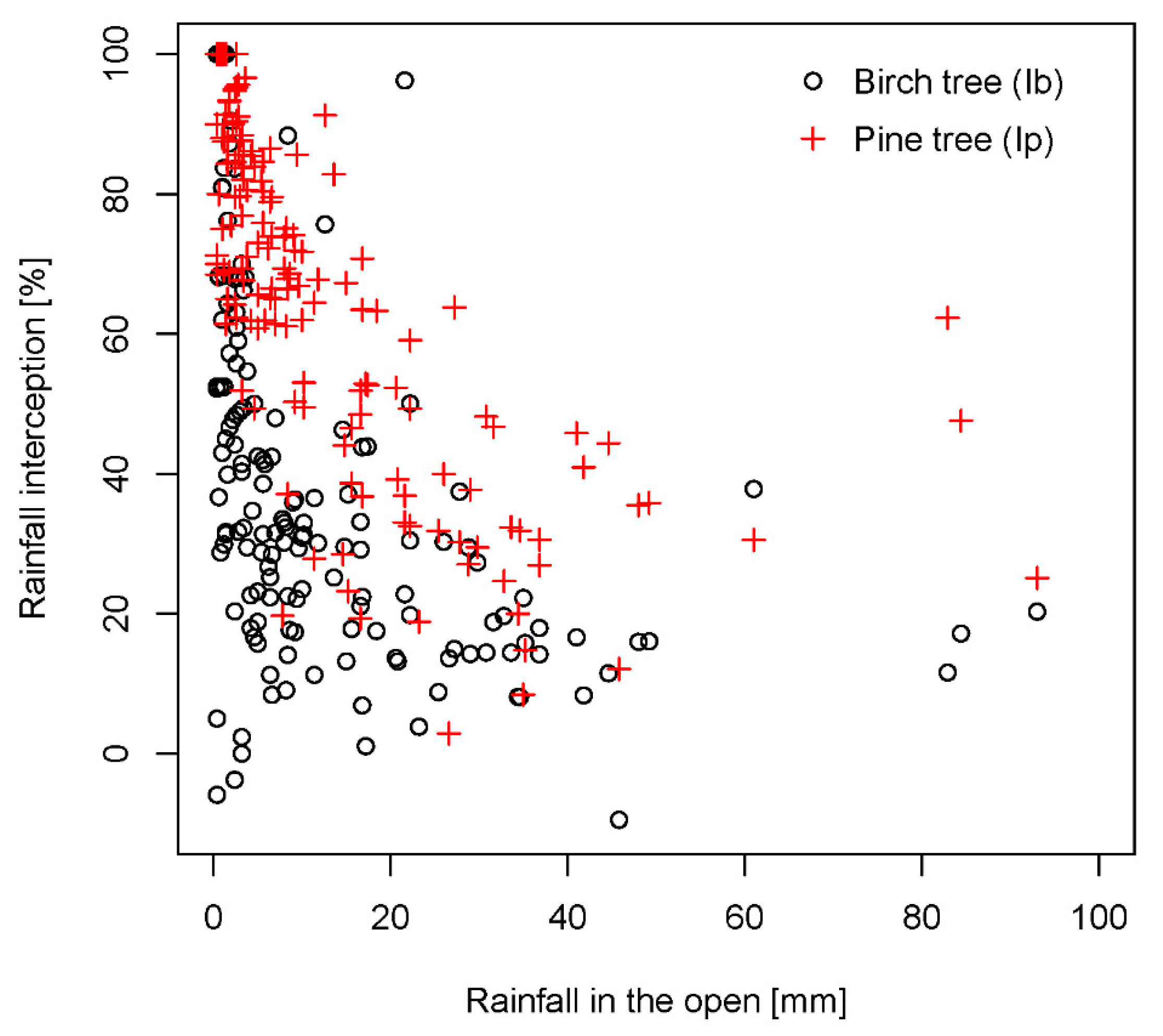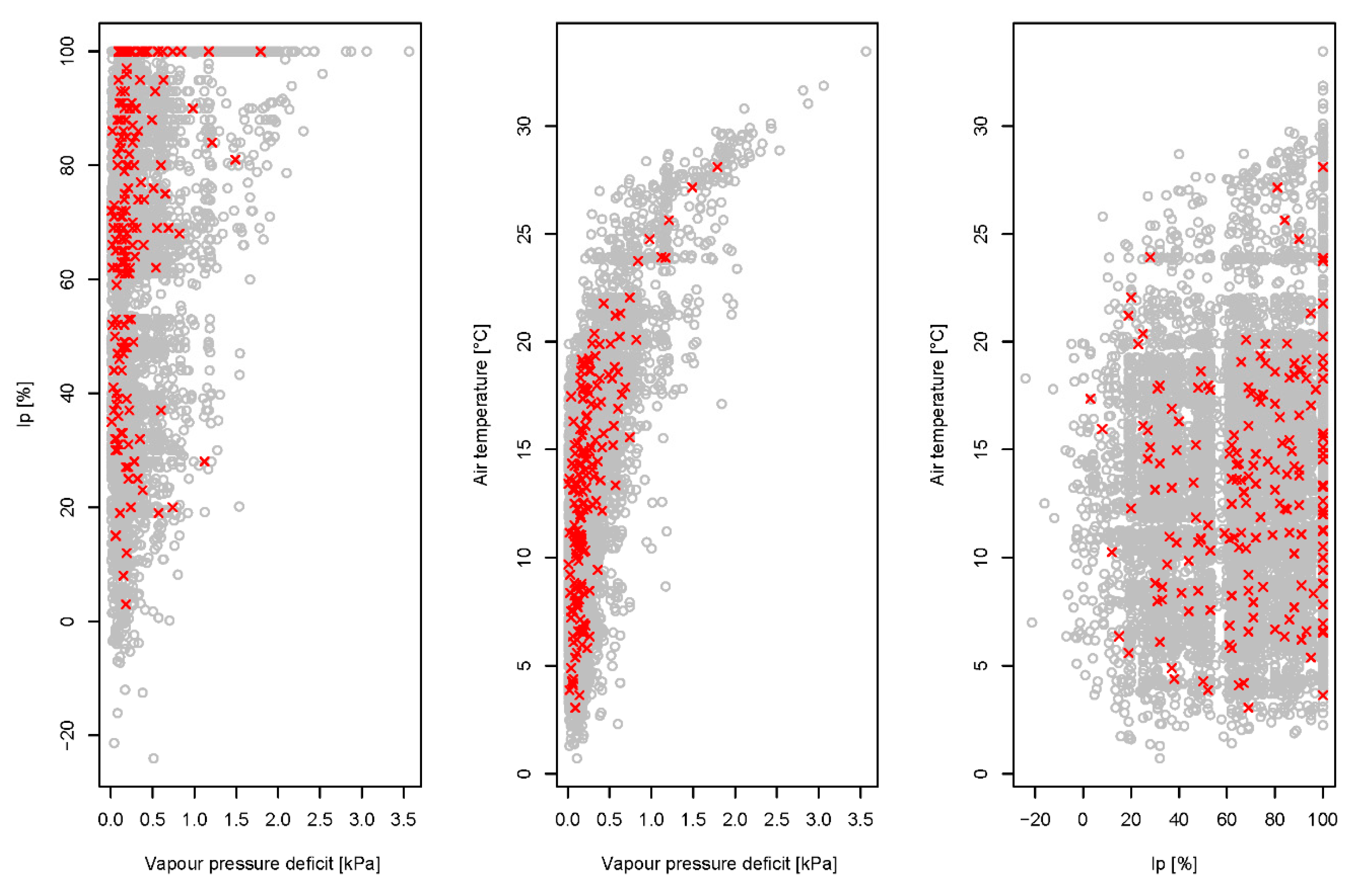Application of Copula Functions for Rainfall Interception Modelling
Abstract
:1. Introduction
2. Materials and Methods
2.1. Rainfall Partitioning Measurements
2.2. Meteorological Variables
2.3. Copulas
2.4. Other Models Used for Estimation of Rainfall Interception and Performance Criteria
3. Results and Discussion
3.1. Rainfall Interception and Influencing Variables
3.2. Selection of the Most Suitable Copula Function
3.3. Comparison of Copula Results with Other Models
4. Conclusions
- The Khoudraji-Liebscher copula model, which has previously been used in a relatively similar application by Bezak et al. [82], can be successfully applied for the estimation of rainfall interception based on air temperature and vapour pressure deficit data.
- The performance of the copula model is relatively similar to the performance of other tested methods. However, according to the RMSE and MAE criteria, slightly better results are obtained using copula functions compared to the other tested methods in this study. The performance of the models could be further improved with the inclusion of other additional variables in the models; however, this would generally increase the complexity of the models. For the EXP method, additional variables cannot be added. For the MLR and copula models, one additional variable would mean one additional parameter. For the decision tree method, the number of parameters is not only connected with the number of variables used, but also with other settings such as maximal tree depth.
- The copula method yielded similar performance for both birch and pine trees despite the fact that the correlation (Table 3) between I-T and I-VPD was smaller for pine trees compared to birch trees. However, correlations between I-T and I-VPD for birch and pine trees were not significantly different with a significance level of 0.05. The constructed models could also be applied for the prediction of rainfall interception under similar vegetation and meteorological conditions in other locations where these two tree species are present. In the case of a longer data series, a different model could be constructed for the leafless and leafed periods.
Author Contributions
Acknowledgments
Conflicts of Interest
References
- Waterloo, M.J.; Bruijnzeel, L.A.; Vugts, H.F.; Rawaqa, T.T. Evaporation from Pinus caribaea plantations on former grassland soils under maritime tropical conditions. Water Resour. Res. 1999, 35, 2133–2144. [Google Scholar] [CrossRef]
- Putuhena, W.M.; Cordery, I. Some hydrological effects of changing forest cover from eucalypts to Pinus radiata. Agric. For. Meteorol. 2000, 100, 59–72. [Google Scholar] [CrossRef]
- Grace, J.M.; Skaggs, R.W.; Chescheir, G.M. Hydrologic and water quality effects of thinning Loblolly Pine. Am. Soc. Agric. Biol. Eng. 2006, 49, 645–654. [Google Scholar]
- Šraj, M.; Brilly, M.; Mikoš, M. Rainfall interception by two deciduous Mediterranean forests of contrasting stature in Slovenia. Agric. For. Meteorol. 2008, 148, 121–134. [Google Scholar] [CrossRef] [Green Version]
- Armson, D.; Stringer, P.; Ennos, A.R. The effect of street trees and amenity grass on urban surface water runoff in Manchester, UK. Urban For. Urban Green. 2013, 12, 282–286. [Google Scholar] [CrossRef]
- Inkiläinen, N.M.; McHale, M.R.; Blank, G.B.; James, A.L.; Nikinmaa, E. The role of the residential urban forest in regulating throughfall: A case study in Raleigh, North Carolina, USA. Landsc. Urban Plan. 2013, 119, 91–103. [Google Scholar] [CrossRef]
- Crockford, R.H.; Richardson, D.P. Partitioning of rainfall into throughfall, stemfow and interception: Effect of forest type, ground cover and climate. Hydrol. Process. 2000, 14, 2903–2920. [Google Scholar] [CrossRef]
- Nanko, K.; Hotta, N.; Suzuki, M. Evaluating the influence of canopy species and meteorological factors on throughfall drop size distribution. J. Hydrol. 2006, 329, 422–431. [Google Scholar] [CrossRef]
- Staelens, J.; De Schrijver, A.; Verheyen, K.; Verhoest, N.E.C. Rainfall partitioning into throughfall, stemflow, and interception within a single beech (Fagus sylvatica L.) canopy: Influence of foliation, rain event characteristics, and meteorology. Hydrol. Process. 2008, 22, 33–45. [Google Scholar] [CrossRef]
- Van Stan, J.T.; Siegert, C.M.; Levia, D.F.; Scheick, C.E. Effects of wind-driven rainfall on interception and stemflow generation between two codominant tree species with differing crown characteristics. Agric. For. Meteorol. 2011, 151, 1277–1286. [Google Scholar] [CrossRef]
- Zabret, K. The influence of tree characteristics on rainfall interception. Acta Hydrotech. 2013, 26, 99–116. (In Slovenian) [Google Scholar]
- Van Stan, J.T.; Van Stan, J.H.; Levia, D.F. Meteorological influences on stemflow generation across diameter size classes of two morphologically distinct deciduous species. Int. J. Biometeorol. 2014, 58, 2059–2069. [Google Scholar] [CrossRef] [PubMed]
- Zabret, K.; Rakovec, J.; Mikoš, M.; Šraj, M. Influence of Raindrop Size Distribution on Throughfall Dynamics under Pine and Birch Trees at the Rainfall Event Level. Atmosphere 2017, 8, 240. [Google Scholar] [CrossRef]
- Zabret, K.; Rakovec, J.; Šraj, M. Influence of meteorological variables on rainfall partitioning for deciduous and coniferous tree species in urban area. J. Hydrol. 2018, 558, 29–41. [Google Scholar] [CrossRef]
- Xiao, Q.; McPherson, E.G.; Ustin, S.L.; Grismer, M.E.; Simpson, J.R. Winter rainfall interception by two mature open-grown trees in Davis, California. Hydrol. Process. 2000, 14, 763–784. [Google Scholar] [CrossRef]
- Toba, T.; Ohta, T. An observational study of the factors that influence interception loss in boreal and temperate forests. J. Hydrol. 2005, 313, 208–220. [Google Scholar] [CrossRef]
- Siegert, C.M.; Levia, D.F. Seasonal and meteorological effects on differential stemflow funneling ratios for two deciduous tree species. J. Hydrol. 2014, 519, 446–454. [Google Scholar] [CrossRef]
- Iida, S.; Levia, D.F.; Shimizu, A.; Shimizu, T.; Tamai, K.; Nobuhiro, T.; Kabeya, N.; Noguchi, S.; Sawano, S.; Araki, M. Intrastorm scale rainfall interception dynamics in a mature coniferous forest stand. J. Hydrol. 2017, 548, 770–783. [Google Scholar] [CrossRef]
- Guevara-Escobar, A.; Gonzalez-Sosa, E.; Veliz-Chavez, C.; Ventura-Ramos, E.; Ramos-Salinas, M. Rainfall interception and distribution patterns of gross precipitation around an isolated Ficus benjamina tree in an urban area. J. Hydrol. 2007, 333, 532–541. [Google Scholar] [CrossRef]
- Muzylo, A.; Llorens, P.; Domingo, F. Rainfall partitioning in a deciduous forest plot in leafed and leafless periods. Ecohydrology 2012, 5, 759–767. [Google Scholar] [CrossRef]
- Van Stan, J.T.; Coenders-Gerrits, M.; Dibble, M.; Bogeholz, P.; Norman, Z. Effects of phenology and meteorological disturbance on litter rainfall interception for a Pinus elliottii stand in the southeastern United States. Hydrol. Process. 2017, 31, 3719–3728. [Google Scholar] [CrossRef]
- Nanko, K.; Hudson, S.A.; Levia, D.F. Differences in throughfall drop size distributions in the presence and absence of foliage. Hydrol. Sci. J. 2016, 61, 620–627. [Google Scholar] [CrossRef]
- Calder, I.R. Dependence of rainfall interception on drop size: 1. Development of the two-layer stochastic model. J. Hydrol. 1996, 185, 363–378. [Google Scholar] [CrossRef]
- Hall, R.L. Interception loss as a function of rainfall and forest types: Stochastic modelling for tropical canopies revisited. J. Hydrol. 2003, 280, 1–12. [Google Scholar] [CrossRef]
- Su, L.; Zhao, C.; Xu, W.; Xie, Z. Modelling interception loss using the revised Gash model: A case study in a mixed evergreen and deciduous broadleaved forest in China. Ecohydrology 2016, 9, 1580–1589. [Google Scholar] [CrossRef]
- Huang, J.Y.; Black, T.A.; Jassal, R.A.; Les Lavkulich, L.M. Modelling rainfall interception by urban trees. Can. Water Resour. J. 2017, 42, 336–348. [Google Scholar] [CrossRef]
- Gash, J.H.C.; Lloyd, C.R.; Lachaud, G. Estimating sparse forest rainfall interception with an analytical model. J. Hydrol. 1995, 170, 79–86. [Google Scholar] [CrossRef]
- Rutter, A.J.; Kershaw, K.A.; Robins, P.C.; Morton, A.J. A predictive model of rainfall interception in forests, I. Derivation of the model from observations in a stand of Corsican pine. Agric. Meteorol. 1971, 9, 367–384. [Google Scholar] [CrossRef]
- De Michele, C.; Salvadori, G.A. Generalized Pareto intensity-duration model of storm rainfall exploiting 2-Copulas. J. Geophys. Res. Atmos. 2003, 108. [Google Scholar] [CrossRef]
- Salvadori, G.; De Michele, C. Frequency analysis via copulas: Theoretical aspects and applications to hydrological events. Water Resour. Res. 2004, 40, W12511. [Google Scholar] [CrossRef]
- Salvadori, G.; De Michele, C.; Durante, F. On the return period and design in a multivariate framework. Hydrol. Earth Syst. Sci. 2011, 15, 3293–3305. [Google Scholar] [CrossRef] [Green Version]
- Zhang, L.; Singh, V.P. Bivariate rainfall frequency distributions using Archimedean copulas. J. Hydrol. 2007, 332, 93–109. [Google Scholar] [CrossRef]
- Wang, X.; Gebremichael, M.; Yan, J. Weighted likelihood copula modeling of extreme rainfall events in Connecticut. J. Hydrol. 2010, 390, 108–115. [Google Scholar] [CrossRef]
- Callau Poduje, A.C.; Haberlandt, U. Short time step continuous rainfall modeling and simulation of extreme events. J. Hydrol. 2017, 552, 192–197. [Google Scholar] [CrossRef]
- De Luca, D.L.; Biondi, D. Bivariate Return Period for Design Hyetograph and Relationship with T-Year Design Flood Peak. Water 2017, 9, 673. [Google Scholar] [CrossRef]
- Jun, C.; Qin, X.; Gan, T.Y.; Tung, Y.-K.; De Michele, C. Bivariate frequency analysis of rainfall intensity and duration for urban stormwater infrastructure design. J. Hydrol. 2017, 553, 374–383. [Google Scholar] [CrossRef]
- Wang, L.; Hu, Q.; Wang, Y.; Zhu, Z.; Li, L.; Liu, Y.; Cui, T. Using Copulas to Evaluate Rationality of Rainfall Spatial Distribution in a Design Storm. Water 2018, 10, 758. [Google Scholar] [CrossRef]
- Gyasi-Agyei, Y. Copula-based daily rainfall disaggregation model. Water Resour. Res. 2011, 47, W07535. [Google Scholar] [CrossRef]
- Gyasi-Agyei, Y. Use of observed scaled daily storm profiles in a copula based rainfall disaggregation model. Adv. Water Resour. 2012, 45, 26–36. [Google Scholar] [CrossRef]
- Singh, V.P.; Zhang, L. IDF curves using the Frank Archimedean copula. J. Hydrol. Eng. 2007, 12, 651–662. [Google Scholar] [CrossRef]
- Ariff, N.M.; Jemain, A.A.; Ibrahim, K.; Zin, W.Z.W. IDF relationships using bivariate copula for storm events in Peninsular Malaysia. J. Hydrol. 2012, 470, 158–171. [Google Scholar] [CrossRef]
- Bezak, N.; Šraj, M.; Mikoš, M. Copula-based IDF curves and empirical rainfall thresholds for flash floods and rainfall-induced landslides. J. Hydrol. 2016, 541, 272–284. [Google Scholar] [CrossRef]
- Serinaldi, F. A multisite daily rainfall generator driven by bivariate copula-based mixed distributions. J. Geophys. Res. Atmos. 2009, 114, D10103. [Google Scholar] [CrossRef]
- Bardossy, A.; Pegram, G.G.S. Copula based multisite model for daily precipitation simulation. Hydrol. Earth Syst. Sci. 2009, 13, 2299–2314. [Google Scholar] [CrossRef] [Green Version]
- Vandenberghe, S.; Verhoest, N.E.C.; Buyse, E.; De Baets, B. A stochastic design rainfall generator based on copulas and mass curves. Hydrol. Earth Syst. Sci. 2010, 7, 3613–3648. [Google Scholar] [CrossRef]
- Wong, G.; Lambert, M.F.; Leonard, M.; Metcalfe, A.V. Drought analysis using trivariate copulas conditional on climatic states. J. Hydrol. Eng. 2010, 15, 129–141. [Google Scholar] [CrossRef]
- Liu, C.L.; Zhang, Q.; Singh, V.P.; Cui, Y. Copula-based evaluations of drought variations in Guangdong, south China. Nat. Hazards 2011, 59, 1533–1546. [Google Scholar] [CrossRef]
- Ganguli, P.; Reddy, M.J. Risk assessment of droughts in Gujarat using bivariate copulas. Water Resour. Manag. 2012, 26, 3301–3327. [Google Scholar] [CrossRef]
- Ma, M.W.; Song, S.B.; Ren, L.L.; Jiang, S.H.; Song, J.L. Multivariate drought characteristics using trivariate Gaussian and Student t copulas. Hydrol. Process. 2013, 27, 1175–1190. [Google Scholar] [CrossRef]
- Zhang, Q.; Xiao, M.Z.; Singh, V.P.; Chen, X.H. Copula-based risk evaluation of droughts across the Pearl River Basin, China. Theor. Appl. Climatol. 2013, 111, 119–131. [Google Scholar] [CrossRef]
- Yusof, F.; Hui-Mean, F.; Suhaila, J.; Yusof, Z. Characterisation of drought properties with bivariate copula analysis. Water Resour. Manag. 2013, 27, 4183–4207. [Google Scholar] [CrossRef]
- Zhang, D.D.; Yan, D.H.; Lu, F.; Wang, Y.C.; Feng, J. Copula-based risk assessment of drought in Yunnan Province, China. Nat. Hazards 2015, 75, 2199–2220. [Google Scholar] [CrossRef]
- Tosonoglu, F.; Onof, C. Joint modelling of drought characteristics derived from historical and synthetic rainfalls: Application of Generalized Linear Models and Copulas. J. Hydrol. Reg. Stud. 2017, 14, 167–191. [Google Scholar] [CrossRef]
- Azam, M.; Maeng, S.J.; Kim, H.S.; Murtazaev, A. Copula-Based Stochastic Simulation for Regional Drought Risk Assessment in South Korea. Water 2018, 10, 359. [Google Scholar] [CrossRef]
- Van de Vyver, H.; Van den Bergh, J. The Gaussian copula model for the joint deficit index for droughts. J. Hydrol. 2018, 561, 987–999. [Google Scholar] [CrossRef]
- De Michele, C.; Salvadori, G.; Vezzoli, R.; Pecora, S. Multivariate assessment of droughts: Frequency analysis and Dynamic Return Period. Water Resour. Res. 2013, 49, 6985–6994. [Google Scholar] [CrossRef]
- Salvadori, G.; De Michele, C. Multivariate real-time assessment of droughts via Copula-based multi-site Hazard Trajectories and Fans. J. Hydrol. 2015, 526, 101–115. [Google Scholar] [CrossRef]
- Salvadori, G.; De Michele, C. Statistical characterization of temporal structure of storms. Adv. Water Resour. 2006, 29, 827–842. [Google Scholar] [CrossRef]
- Vandenberghe, S.; Verhoest, N.E.C.; De Baets, B. Fitting bivariate copulas to the dependence structure between storm characteristics: A detailed analysis based on 105 year 10 min rainfall. Water Resour. Res. 2010, 46, W01512. [Google Scholar] [CrossRef]
- Balistrocchi, M.; Bacchi, B. Modelling the statistical dependence of rainfall event variables through copula functions. Hydrol. Earth Syst. Sci. 2011, 15, 1959–1977. [Google Scholar] [CrossRef] [Green Version]
- Zhang, Q.; Li, J.; Singh, V.P. Application of Archimedean copulas in the analysis of the precipitation extremes: Effects of precipitation changes. Theor. Appl. Climatol. 2012, 107, 255–264. [Google Scholar] [CrossRef]
- De Paola, F.; Giugni, M. Coupled spatial distribution of rainfall and temperature in USA. Procedia Environ. Sci. 2013, 19, 178–187. [Google Scholar] [CrossRef]
- Gouveia-Reis, D.; Guerreiro Lopes, L.; Mendonça, S. A dependence modelling study of extreme rainfall in Madeira Island. Phys. Chem. Earth Parts A/B/C 2016, 94, 85–93. [Google Scholar] [CrossRef] [Green Version]
- Tosunoglu, F.; Can, I. Application of copulas for regional bivariate frequency analysis of meteorological droughts in Turkey. Nat. Hazards 2016, 82, 1457–1477. [Google Scholar] [CrossRef]
- Zabret, K.; Šraj, M. Spatial variability of throughfall under single birch and pine tree canopies. Acta Hydrotech. 2018, 31, 1–20. [Google Scholar]
- ARSO (Agencija Republike Slovenije za Okolje). Available online: http://www.arso.gov.si/ (accessed on 10 January 2018).
- Zabret, K.; Šraj, M. Can Urban Trees Reduce the Impact of Climate Change on Storm Runoff? Urbani Izziv 2015, 26, S165–S178. [Google Scholar] [CrossRef]
- Levia, D.F.; Van Stan, J.T.; Mage, S.M.; Kelley-Hauske, P.W. Temporal variability of stemflow volume in a beech-yellow poplar forest in relation to tree species and size. J. Hydrol. 2010, 380, 112–120. [Google Scholar] [CrossRef]
- Livesley, S.J.; Baudinette, B.; Glover, D. Rainfall interception and stemflow by eucalypt street trees—The impacts of canopy density and bark type. Urban For. Urban Green. 2014, 13, 192–197. [Google Scholar] [CrossRef]
- Nadbath, M. Meteorološka Postaja Ljubljana Bežigrad Meteorological Station Ljubljana Bežigrad. Naše Okolje 2008, 35–41. Available online: http://meteo.arso.gov.si/uploads/probase/www/climate/text/sl/stations/ljubljana-bezigrad.pdf (accessed on 1 July 2018). (In Slovenian).
- Allen, R.G.; Pereira, R.S.; Raes, D.; Smith, M. Crop Evapotranspiration—Guidelines for 487 Computing Crop Water Requirements; FAO Irrigation and Drainage Paper 56; FAO: Rome, Italy, 1998. [Google Scholar]
- R Development Core Team. R: A Language and Environment for Statistical Computing; R Foundation for Statistical Computing: Vienna, Austria, 2015. [Google Scholar]
- Sklar, M. Fonction de répartition à n dimensions et leurs marges. Publ. Inst. Stat. Univ. Paris 1959, 8, 229–231. [Google Scholar]
- Joe, H. Multivariate Models and Dependence Concepts; Chapman & Hall: London, UK; New York, NY, USA, 1997. [Google Scholar]
- Nelsen, R.B. An Introduction to Copulas; Springer: New York, NY, USA, 2006. [Google Scholar]
- Salvadori, G.; De Michele, C.; Kottegoda, N.T.; Rosso, R. Extremes in Nature: An Approach Using Copulas; Springer: Dordrecht, The Netherlands, 2007. [Google Scholar]
- Durante, F.; Sempi, C. Principles of Copula Theory; CRC/Chapman & Hall: Boca Raton, FL, USA, 2015. [Google Scholar]
- Khoudraji, A. Contributions à L’étude des Copules et àla Modélisation des Valeurs Extremes Bivariées. Ph.D. Thesis, Université Laval, Quebec City, QC, Canada, 1995. [Google Scholar]
- Liebscher, E. Construction of asymmetric multivariate copulas. J. Multivar. Anal. 2008, 99, 2234–2250. [Google Scholar] [CrossRef]
- Durante, F.; Salvadori, G. On the construction of multivariate extreme value models via copulas. Environmetrics 2010, 21, 143–161. [Google Scholar] [CrossRef]
- Salvadori, G.; De Michele, C. Multivariate multiparameter extreme value models and return periods: A copula approach. Water Resour. Res. 2010, 46, W10501. [Google Scholar] [CrossRef]
- Bezak, N.; Rusjan, S.; Kramar Fijavž, M.; Mikoš, M.; Šraj, M. Estimation of Suspended Sediment Loads Using Copula Functions. Water 2017, 9, 628. [Google Scholar] [CrossRef]
- Genest, C.; Ghoudi, K.; Rivest, L.P. A semiparametric estimation procedure of dependence parameters in multivariate families of distributions. Biometrika 1995, 82, 543–552. [Google Scholar] [CrossRef]
- Kojadinovic, I.; Yan, J. Modelling Multivariate Distributions with Continuous Margins Using the copula R Package. J. Stat. Softw. 2010, 34. [Google Scholar] [CrossRef]
- Genest, C.; Remillard, B.; Beaudoin, D. Goodness-of-fit tests for copulas: A review and a power study. Insur. Math. Econ. 2009, 44, 199–213. [Google Scholar] [CrossRef]
- Grønneberg, S.; Hjort, N.L. The copula information criteria. Scand. J. Stat. 2014, 41, 436–459. [Google Scholar] [CrossRef] [Green Version]
- Hutson, A.D. A semi-parametric quantile function estimator for use in bootstrap estimation procedures. Stat. Comput. 2002, 12, 331–338. [Google Scholar] [CrossRef]
- Serinaldi, F. Assessing the applicability of fractional order statistics for computing confidence intervals for extreme quantiles. J. Hydrol. 2009, 376, 528–541. [Google Scholar] [CrossRef]
- Naimi, B.; Hamm, N.; Groen, T.A.; Skidmore, A.K.; Toxopeus, A.G. Where is positional uncertainty a problem for species distribution modelling. Ecography 2014, 37, 191–203. [Google Scholar] [CrossRef]
- Loh, W. Classification and regression trees. Data Min. Knowl. Discov. 2011, 1, 14–23. [Google Scholar] [CrossRef]
- Demšar, J.; Curk, T.; Erjavec, A.; Gorup, C.; Hočevar, T.; Milutinovič, M.; Možina, M.; Polajnar, M.; Toplak, M.; Starič, A.; et al. Orange: Data Mining Toolbox in Python. J. Mach. Learn. Res. 2013, 14, 2349–2353. [Google Scholar]
- Herbst, M.; Rosier, P.T.W.; McNeil, D.D.; Harding, R.J.; Gowing, D.J. Seasonal variability of interception evaporation from the canopy of a mixed deciduous forest. Agric. For. Meteorol. 2008, 148, 1655–1667. [Google Scholar] [CrossRef] [Green Version]
- Siegert, C.M.; Levia, D.F.; Hudson, S.A.; Dowtin, A.L.; Zhang, F.; Mitchell, M.J. Small-scale topographic variability influences tree species distribution and canopy throughfall partitioning in a temperate deciduous forest. For. Ecol. Manag. 2016, 359, 109–117. [Google Scholar] [CrossRef]
- Carlyle-Moses, D.E.; Lishman, C.E.; McKee, A. A preliminary evaluation of throughfall sampling techniques in a mature coniferous forest. J. For. Res. 2014, 25, 407–413. [Google Scholar] [CrossRef]
- Asadian, Y.; Weiler, M. A new approach in measuring rainfall interception by urban trees in coastal British Columbia. Water Qual. Res. J. Can. 2009, 44, 16–25. [Google Scholar] [CrossRef]






| Copula | |
|---|---|
| Joe | |
| Frank | |
| Clayton | |
| Gumbel-Hougaard |
| Variable | Min | Max | Mean | Median | CV |
|---|---|---|---|---|---|
| T | 3.0 °C | 28.1 °C | 13.4 °C | 13.4 °C | 38.5 |
| RH | 53.0% | 99.3% | 85.6% | 88.0% | 10.6 |
| VPD | 0.01 kPa | 1.79 kPa | 0.26 kPa | 0.18 kPa | 102 |
| Ib | −9% | 100% | 40% | 33% | 67.4 |
| Ip | 3% | 100% | 68% | 71% | 36.9 |
| Pairs | Birch Tree | Pine Tree |
|---|---|---|
| I-T | 0.16 (0.002) | 0.08 (0.10) |
| I-VPD | 0.30 (8.9 × 10−9) | 0.19 (0.001) |
| T-VPD | 0.48 (2.2 × 10−16) | 0.48 (2.2 × 10−16) |
| Birch Tree | Pine Tree | |||
|---|---|---|---|---|
| Model | RMSE [%] | MAE [%] | RMSE [%] | MAE [%] |
| Copula | 24.21 | 18.16 | 24.95 | 19.62 |
| Exponential function | 24.70 | 19.62 | 24.64 | 20.27 |
| Multiple regression model (MLR) | 25.29 | 20.14 | 24.94 | 20.58 |
| Decision tree | 26.92 | 20.88 | 27.75 | 22.11 |
© 2018 by the authors. Licensee MDPI, Basel, Switzerland. This article is an open access article distributed under the terms and conditions of the Creative Commons Attribution (CC BY) license (http://creativecommons.org/licenses/by/4.0/).
Share and Cite
Bezak, N.; Zabret, K.; Šraj, M. Application of Copula Functions for Rainfall Interception Modelling. Water 2018, 10, 995. https://doi.org/10.3390/w10080995
Bezak N, Zabret K, Šraj M. Application of Copula Functions for Rainfall Interception Modelling. Water. 2018; 10(8):995. https://doi.org/10.3390/w10080995
Chicago/Turabian StyleBezak, Nejc, Katarina Zabret, and Mojca Šraj. 2018. "Application of Copula Functions for Rainfall Interception Modelling" Water 10, no. 8: 995. https://doi.org/10.3390/w10080995






